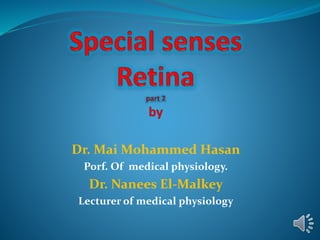
Retina 2
- 1. Dr. Mai Mohammed Hasan Porf. Of medical physiology. Dr. Nanees El-Malkey Lecturer of medical physiology
- 2. By the end of this lecture the students are expected to: Identify retinal changes on exposure to light . Recognize the physiology of color vision. Identify visual field
- 3. Retinal changes on exposure to light 1. Structural changes: • spread of melanin in pigmented cell layer 2. Chemical changes • Degradation of visual pigment 3. Electerical changes: • Recorded by electro-retino-graph
- 4. Electro-retino gram „Electroretinogram (ERG) is the record of electrical activity in retina When light rays stimulate it. receptors ganglion cells Pigmented epithelum repolarization
- 5. ELECTRORETINOGRAM • ‘A’, ‘B’ and ‘C’ waves occur when light stimulus falls on retina. ‘D’ wave occurs when light stimulus is stopped. • ‘A’ wave: arises from rods and cones. • ‘B’ wave: arises from ganglion cells • ‘C’ wave: arises from pigment epithelial layer • ‘D’ wave: arises from receptor repolarization.
- 6. Purkinje phenomenon : the yellow part of the spectrum appears as the brightest i.e. it has the lowest threshold ability to stimulate retina. : this high sensitivity is shifted from yellow to blue green which will have the maximal luminosity.
- 8. COLOR VISION Color vision is the sense of discrimination of the wave lengths that constitute the visible spectrum. Important definitions about color vision: - 1- Hue is the actual nature of the color i.e. red, yellow this depends upon the wavelength of the color. 2- Saturation is the degree of purity of the color from the white color. 3-Brightness or luminosity is the degree of intensity of the rays that are reflected from colored object.
- 9. 4-Primary colors when their wave lengths are mixed in an equal proportion and stimulate the retina can give the sensation of white color. 5-Complementary colors for any color their is a complementary color, when their wave lengths are mixed together properly by certain proportion can give the sensation of white color. 6- Black is that sensation which produced by complete absence of light .
- 11. Theories of color vision A-Trichromatic theory (Young - Helmholtz theory) 1. There are 3 types of cones each one is maximally sensitive to one of the primary color. First cone contains pigment that is maximally sensitive to blue violet part of the spectrum Second cone contains pigment that is maximally sensitive to green portion of spectrum, Third cone contains pigment that is maximally sensitive to the red portion of the spectrum.
- 12. Each color stimulates the 3 cones in unequal manner The frequency and intensity of impulses reaching the visual cortex are different
- 13. B-Neural theory of color vision states that perception of colors is mainly a function of group of neural cells starts at small ganglion cells in the retina which are stimulated by certain color . Types of ganglion cells : • W (40%) cells receive most of their excitation from Rods,. • X cells (55%) transmit fine details of visual images, responsible for color vision. They are connected to P Cells of lateral geniculate body. • Y cells (5%) respond to rapid changes in visual images, they are connected to M cells of lateral geniculate body
- 14. Color Blindness Color blindness is most commonly hereditary disorder (recessive sex - linked) A- Trichromate: The patient has the 3 cones but one of them is weak. B-Dichromate : One cone is totally absent and the other two are present. Thus patient cannot perceive a certain color Monchromate: the patient have only one cone system and matches the different colors as various degrees this color.
- 15. Tests of color vision: 1-Colour matching test: patient is given group of colored tufted wool and is asked to separate similar colored pieces together. 2- Edridge - Green lantern test :-in which the person has to identify the color of a small illuminated area the size of which can be varied.
- 16. 3-Ishihara's chart test: these are colored printed figures and each figure is printed by many different colored small circles on a background of colored circles also.
- 17. After Image Phenomena These are visual sensations which can be detected after removal of the primary visual stimuli. 1. Positive after image: When a person looks to specially a bright object for a short time then he closes his eyes, the image of that object, still appear in front of him for many seconds. 2. Negative after image: If a person looks to certain bright colored picture or to a scene for at least 30 seconds then he turns his eyes to white surface, the picture will remain in front of him for sometime but the black parts in the picture will appear white and the white parts will appear black.
- 18. Flickers: can be defined as the ability of the eye to perceive successive visual stimuli as an intermittent light sensation. The point at which flicker just disappear is known as the critical fusion frequency (CFF), when the flicker moves at a speed of 25 times / second .
- 19. refers to the total area in the world which can be seen by single ey It is not circular as It is cut medially by the nose (60 degree) Upward by the supraorbital ridges (50 degree) Downwards by the checks (80 degree) Laterally extended up to (90 degree) The visual field
- 20. Visual field
- 21. How the Test visual field: 1. Confrontation test 2. perimertry
- 22. Importance of determination of the visual field: 1. It greatly helps in localization of the sites of lesions in the visual pathway. 2. A blind spot in the visual field is called "Scotoma". 3. It helps in diagnosis of some retinal diseases
- 23. Thank you